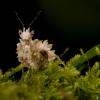I purchased a number of plastic 16mm x 150mm test tubes. I'm currently filling them reliably with queens, but they seem to do so poorly with grip. I'm new and love checking my ants every couple days. I can't help it. They don't hold the plastic well. had anyone looked into some kind of coating for the tubes for queens to grip? Maybe my queens are weak, but they seem to just fall over, unable to hold fast to their temporary homes.
Maybe a thin coating of grout-water along the bottom, dried thoroughly, would give them a holdfast without losing the clarity and water retention? Does anyone have this issue or are my tetramorium just in poor health?

















